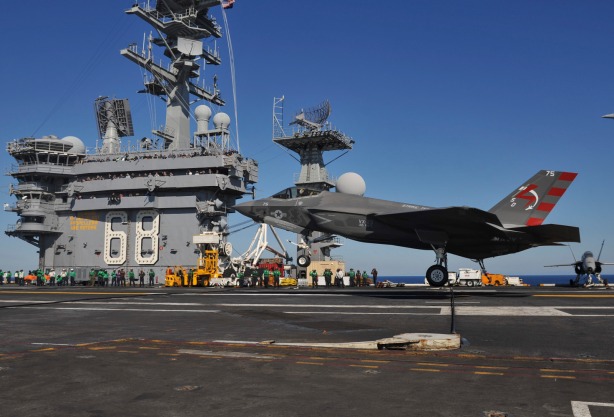
Even though no model has been officially announced, it appears as if Hobby Master will soon be rolling out the third and perhaps most important version of the F-35 Joint Strike Fighter. Larger than either the A or B variants, the C version of the JSF (CV) is flown by the US Navy and features larger wings, a wider splayed tail assembly, more robust landing gear for catapult launches and fly-in arrestments, greater payload and fuel capacity and other things under the hood. With their October product schedule already in the public’s hands, its likely that the first C replica will come out just before the holidays.
Lockheed Martin has this to say about the F-35C (CV) variant. “Aircraft carriers remain at the forefront of U.S. military power, and the backbone of any carrier strike group is the aircraft it brings to the fight. The 5th Generation F-35C Lightning II is the only fighter that can respond to tomorrow’s threats and preserve the U.S. Navy’s maritime supremacy. Our naval aviators deserve nothing less than the most advanced capabilities to ensure they are able to perform their missions and return home safely.
More than 50 years of aircraft carrier-based fighter evolution culminates in the F-35C. Never before has low observable stealth been available at sea. The F-35C carrier variant (CV) is the world’s only 5th Generation, long-range stealth strike fighter designed and built explicitly for carrier operations.The U.S. Navy is the largest customer receiving F-35Cs, with the U.S. Marine Corps also planning to acquire the C variant in addition to the F-35B.
The F-35C combines this unique capability of operating from a carrier deck with the unmatched 5th Generation capabilities of stealth, fused sensors and reliability, making the F-35C the Navy’s future first-day-of-the-war strike fighter.
The Navy and Marines require an aircraft capable of overcoming a variety of threats — surface-to-air missiles, air-to-air missiles and tactical aircraft. By leveraging this potent combination of stealth, advanced jamming and threat system destruction, the F-35C enhances survivability and increases mission success rates.
The F-35C variant has larger wings and more robust landing gear than the other variants, making it suitable for catapult launches and fly-in arrestments aboard naval aircraft carriers. Its wingtips also fold to allow for more room on the carrier’s deck while deployed.

The F-35C also has the greatest internal fuel capacity of the three F-35 variants. The F-35C carries nearly 20,000 pounds of internal fuel for longer range and better persistence than any other fighter in a combat configuration. And, like the F-35B, the F-35C uses probe and drogue refueling. This allows the Navy to operate its carriers a safe distance from the threat while its fighters reach remote targets.”
Recognizing the importance of differentiating between each type of F-35 and their effects on each service branch, we have decided to further separate the Hobby Master F-35 section into three distinct sub categories. We have also learned that the Hobby Master rendition of the F-35 variant will not feature folding wing tips to make it more compact on an aircraft carrier. No reason was given for the design omission and its entirely possible the manufacturer could reverse this decision.

